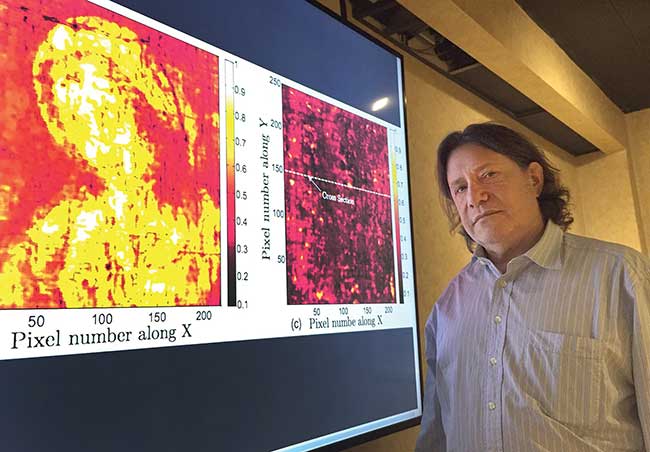There has long been an air of mystery surrounding paintings created prior to the 18th century and how the artists prepared their canvases, applied undercoats and eventually created their masterpieces.
Researchers from Georgia Tech-Lorraine, a campus of the Georgia Institute of Technology, in Metz, France, are using 21st-century signal processing via time-domain terahertz (THz) techniques to uncover the secrets of renowned 17th-century artists, paint layer by paint layer.

Georgia Tech-Lorraine professor David Citrin is shown with images produced by a terahertz imaging technique. Researchers studied a 17th-century painting using a terahertz reflectometry technique to analyze individual paint layers. Courtesy of John Toon.
Using a Spectra TPS 3000 — a commercial time-domain THz scanner produced by TeraView — the researchers studied the painting “Madonna in Preghiera” created in the workshop of Giovanni Battista Salvi da Sassoferrato, which was on loan from the Musée de la Cour d’Or, Metz Métropole. Georgia Tech-Lorraine professor David Citrin told Photonics Media that the painting was examined approximately every 200 microns. An electromagnetic wave generator within the scanner then produced signals from each layer of the painting.
“In carrying out time-domain reflectometry, the reflected signal is the sum of reflected terahertz pulses from the interfaces between various layers in the painting,” said Citrin. “If the layers are thick, then these echoes do not strongly overlap in time and appear distinct. If, however, the layers are sufficiently thin, as is the case in most oil paintings on canvas predating the 20th century, the echoes from successive layers strongly overlap in time, and thus reconstructing the stratigraphy becomes difficult.”
The researchers found that the painting’s layers were reasonably distinct and the intrinsic reflected signal was composed of a sequence of very narrow peaks. Using a signal processing technique known as sparsity-based time-domain deconvolution, they were able to separate the reflected signals layer by layer to construct a 3D map of the painting. In doing so, they uncovered the canvas support, ground, imprimatura, underpainting, pictorial and varnish layers, and a previously unknown restoration of the painting’s varnish.

“Madonna in Preghiera” by the workshop of Giovanni Battista Salvi da Sassoferrato. The painting was studied using a terahertz reflectometry technique. Courtesy of Alexandre Locquet.
“This technique allows us to see at high resolution what is beneath the surface of a painting, to assess in depth what kind of technique has been used and to determine what defects may be present,” said Alexandre Locquet, an adjunct professor in Georgia Tech’s School of Electrical and Computer Engineering and a researcher at the Georgia Tech-CNRS international laboratory in Metz.
The images they produced using the nondestructive scanners and processors could help art conservators spot previous restorations of paintings, highlight potential damage and assist in authenticating the old works.
“Clearly, in the physical analysis of art, one seeks nondestructive techniques,” Citrin said. “Such techniques are increasingly used in the analysis of art and cultural heritage.”
“Historical paintings still hide numerous secrets, but curators will now have access to a wealth of additional in-depth information on the physical composition of their artworks,” said Locquet.
The Georgia Tech team will continue to merge the arts and sciences through further explorations of terahertz imaging to help authenticate, conserve and restore historical paintings. Their technique also has potential applications for detecting skin cancer, ensuring proper adhesion of turbine blade coatings and measuring the thickness of automotive paints.